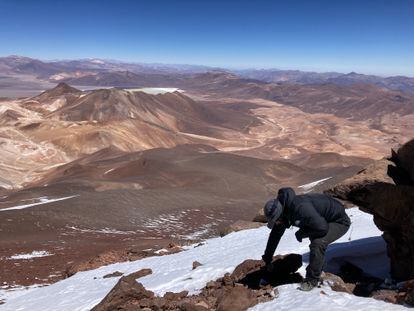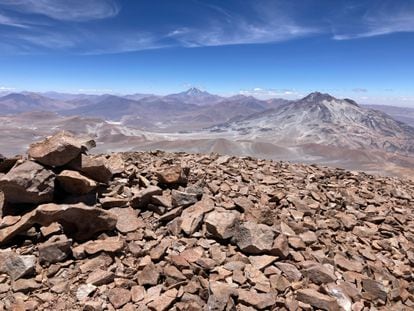EL PAÍS offers the América Futura section openly for its daily and global information contribution on sustainable development. If you want to support our journalism, subscribe here.
At the tops of the Andes mountain range, life seems like a fiction. There is nothing. Immense volcanic peaks that exceed 6,000 meters. They are just a world of stone, ice and snow.
Between 1970 and 1980, archaeologists climbed some of these volcanoes and found rock mounds built by the Incas, the empire that dominated South America until the early 16th century. They are easy to see and they even found mummies attributed to the Capac cocha, a ceremony that included child sacrifices. Among those ruins, they also found the remains of some mice. They speculated that those rodents had been transported—perhaps by chance—by the indigenous people themselves. They didn't believe they would arrive on their own.
In 2011, on one of these Andean peaks, at about 6,200 meters above sea level, an anthropologist and a doctor found a naturally mummified mouse. Three years later, they fortuitously recorded one of these rodents between rocks and ice; and in 2016 a climber saw a rodent hiding in its lair in Llullaillaco, a 6,739-meter massif in the north on the border of Chile and Argentina, the second highest active volcano in the world.
But it was not until 2020 when Bolivian mountain climber Mario Pérez Mamani noticed the presence of a rodent.
“A mouse!” he pointed out to his partner, the mountaineer and biologist from the University of Nebraska, Jay Storz, who, exhausted and dazed by the altitude, barely noticed the little animal, which quickly hid under a rock. But the American managed to capture it with his hand. He was a Phyllotis vaccarumknown as the long-eared mousepart of the sigmodontines (Sigmodontinae), subfamily that is believed to have crossed to South America more than 3 million years ago, when just a few islands linked the north and south of the continent. These small animals had managed to colonize impossible heights. There was life at the top.
How they got to heaven
That encounter prompted Storz and other biologists to investigate the presence of mice. Between 2020 and 2022, 24 volcanoes in the Andes have risen, in Chile, Bolivia and Argentina. On three of these peaks, they found 13 dead individuals of this rodent: on the Chilean volcanoes Púlar (6,233 meters) and Copiapó (6,052), and Salín (6,029).
“We found life on the summits of very few of them,” admits the Nebraska biologist. “And the long-eared mouse is the most extreme of all.” As he explains, it is the only animal found above 6,000 meters, although there were also remains of other types of rodents at altitudes above 5,000. They are all family Cricetidaeseparated about 18 million years ago from their distant European relatives.
Previously, one hypothesis was that the Incas had something to do with the arrival of these little mice to the peaks, even that some of them sneaked into the firewood they carried to make a fire. “It always seemed crazy to me, because carrying a few sticks on your back, no mouse can endure the trip,” says Guillermo D'Elia, a biologist at the Austral University and one of the co-authors of the study on the long-eared mouse published in the journal Current Biology.

The scientist was skeptical, so with radiocarbon tests they dated the age of these small hairy mummies: most were from around 1950, and one of them from about 350 years ago. That is, much more recent than the fallen Inca empire. This study joins others “that suggest that there are mice residing at those altitudes,” says D'Elia. “They are few, but there are.”
The evidence reinforces that they get there on their own. The mummies they found are males and females, half and half, as would be a “natural population,” he says. The tendency in mammals is for males to move to reproduce, but in these peaks, the sex of the mice found is equal: “If they simply arrived from the top, one would expect to find more males than females,” he speculates. “They make people think they are natural populations,” she remarks.
Tame the peaks
There is still much to know about this species. For this reason, biologists continue working to obtain more information about these rodents, but the mission is arduous. Storz was skilled in mountaineering and, when rumors reached him of a mouse with the world height record, he became interested in investigating it. His two passions crossed.
Each scan lasts three weeks; requires acclimatization to the low oxygen at 6,000 meters. Arrival at the summits must be before noon to descend a few hundred meters to the base camp. Or risk storms. Above, “you usually have time to hug your partner, make a selfie at the summit and bye, because it is dangerous to stay for so long at such heights,” warns the American. “But we also need to do searches for the mummies.” They squeeze time. “In the cases where we found stuffed corpses, they were visible and we didn't have to look as hard,” he says. And, no matter how minimal it may be, there is always chance to find someone P. vaccarum.
The mountains of western Bolivia tend to be snowier than those of northern Chile, in the driest desert on the planet, the Atacama. However, beyond that, “in the volcanoes that we find mummies, at first glance, there is no difference with the others,” admits the biologist. “We don't understand why we have found it on some peaks and not on others,” except when there is a lot of snow that they don't expect to find life. They also found bodies of long-eared mice on peaks that had no archaeological remains. “It's a myst
ery why mice climb some mountains and not others,” he admits.

At the top, breathing is difficult. Exhaust. The mind becomes clouded. It is difficult to think lucidly, but the views are impressive. Lower down—about 3,500 meters—in the arid Puna of Atacama, “it is the best place in the world to look at the night sky,” confesses Storz. “It has a charm; It is not for everyone, it is very austere, almost Martian.”
Two large camelids, vicuñas and guanacos, live there, surrounded by foxes and flamingos in the lagoons. The vegetation is scarce: there are cacti and yaretas, a bush that looks like moss. Up to 5,000, the environment “is a little friendlier,” details D'Elia. “You can imagine what they can eat and what they can't.” Until then, mice are abundant. At that altitude, the cold is severe at night and the lack of oxygen is already felt. “You get dizzy if you bend down and stand up quickly,” he describes. “Your head and body work in slow motion.” At night, it is difficult to enter deep sleep. The wind twists and bends the bushes.
These little mice hide among the vegetation and rocks, more active at night. Researchers set traps to catch and study them. In places like the Casiri lagoon, at 4,800 meters above sea level, on the border with Bolivia, “everything is very primitive and rudimentary,” he says. “They are very remote places, you don't see many people,” except for the occasional local with his cattle. The roads are rough, diffuse, slow to travel. “And there comes a time when there is nothing: it is sand, volcanic ash, rocks, snow and ice,” he continues. Sulfur fumaroles sprout from the cracks and the ground turns yellow.
Scientists have seen tracks of a puma, the big cat of the Andes, at 5,200 meters. “It's impressive that they walk so high, I imagine they are hunting vicuñas and guanacos,” says Storz. The elusive Andean cats also live there, although he has never seen one. “But it is possible that they have seen us,” he says.
There is nothing to eat
The absence of predators may be one of the reasons the mice reach so high, the researchers speculate. Although, at 6,000 meters high, “they obviously have other problems to face,” admits the American.
D'Elia is not surprised that mammals are the vertebrates that live highest, where there are no lizards or reptiles due to differences in their physiological limit. What is curious is that it is a small rodent: “As you get closer to the poles or high altitudes, the animals are larger,” he says, “because they are “more energy efficient.” But not in the Andes.
Biologists assume that rodents live there year-round and do not migrate. In the laboratory studies, they sequenced the genomes of all 13 mouse bodies. They all belonged to the same species, they compared them with individuals from the highlands and at sea level and barely found any differences between them. “It is as if it were the same large, widely distributed population,” says the scientist.

The certainty that these rodents exist at such altitudes allows them to study the limits of vertebrate life. In Santiago, at the University of Chile, they have some of these mice captured at lower altitudes. With controlled experiments, they seek to unravel how they have evolved for such extreme conditions by comparing them with individuals of “extremely related” species but that do not reach that height.
But just because they are almost genetically identical does not mean that there are no differences, warns D'Elia. More research needs to be done, but he speculates with the possibility that they have a gene that “allows hemoglobin at altitude to be more efficient at capturing oxygen.” And another mystery remains: what do they eat if there is nothing upstairs? They have only identified lichens, very resistant organisms, made up of a fungus and an algae or cyanobacteria. Analysis of the stomach of a mouse that they caught in Llullaillaco shows some plants from the Chilean highlands.
At the moment, with their findings they broke the height record for the long-eared pika (Ochotona macrotis) —more closely related to hares and rabbits—, which was found at 6,130 meters, in the middle of Mount Everest. “There are still areas that have been little explored, not only the Chilean Andes, but also the Peruvian, Ecuadorian and Argentinian Andes,” D'Elia glimpses. “There is a 'final frontier' of exploration that was there, waiting to be visited.”
#Longeared #mice #break #limit #life #Andes